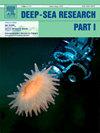Deep-sea nemerteans collected along the Japan Trench and the southern Kuril-Kamchatka Trench onboard the R/V Hakuho-maru with descriptions of two new species in Hoplonemertea
IF 2.1
3区 地球科学
Q2 OCEANOGRAPHY
Deep-Sea Research Part I-Oceanographic Research Papers
Pub Date : 2025-06-30
DOI:10.1016/j.dsr.2025.104549
引用次数: 0
Abstract
A total of 80 nemertean specimens, representing 30 putative species, were obtained from the trawled material collected along the Japan Trench (JT) and southern Kuril-Kamchatka Trench (KKT) during the KH-22-8 and KH-23-5 cruises of the R/V Hakuho-maru in October 2022 and September 2023, respectively. Samples were collected from the 24 stations along these trenches at depths ranging from 2007 to 7654 m. Molecular and morphological analyses revealed nine species of Palaeonemertea (one in Carininidae, eight in Tubulanidae), seven species of Pilidiophora (six in Lineidae, one in Valenciinidae), and 14 species of Hoplonemertea (six Monostilifera, eight Polystilifera). All palaeonemerteans, six pilidiophorans, and eight hoplonemerteans represented species that are highly likely undescribed and distinct from species known in deep-sea environments globally in the last decade. Two new hadal hoplonemerteans were described in this study: Nemertovema kojimai sp. nov. in JT at 6211 m, and Profundonemertes hakuhoae gen. et sp. nov., found in JT and southern KKT at depths of 6807–7654 m. The phylogeny of the 30 species, including the two newly described, was analyzed using 16S, 18S, and 28S ribosomal RNA, cytochrome c oxidase subunit I (COI), and histone H3 genes. Nemertovema kojimai sp. nov. is closely related to Nemertovema norenburgi Chernyshev and Polyakova, 2019, while Profundonemertes hakuhoae gen. et sp. nov. was nested within Oerstediina, sister to Abyssonemertes kajiharai Chernyshev and Polyakova, 2018a, but with low support. Four previously described species were also reported for the first time in Japanese waters: Baseodiscus profundus Kajihara, Abukawa and Chernyshev, 2022b, in southern KKT; Dinonemertes cf. arctica Korotkevich, 1977 in both trenches; N. norenburgi, in southern KKT; and Phallonemertes murrayi (Brinkmann, 1912), in both trenches as well. The genus Nemertovema Chernyshev and Polyakova, 2018a was reported for the first time in JT, represented by N. kojimai sp. nov. and one additional undescribed species. This study provided the first comprehensive survey of deep-sea nemertean diversity along JT and updated our understanding of species diversity in KKT.
R/V Hakuho-maru号在日本海沟和南千岛-堪察加海沟收集的深海海参,描述了Hoplonemertea的两个新物种
对2022年10月和2023年9月“白虎丸”号在日本海沟(JT)和千岛-堪察加海沟(KKT)南部进行的KH-22-8和KH-23-5巡航中收集的拖网材料进行了研究,共获得了80个nemertea标本,代表30种推测物种。样品采集自这些海沟沿线的24个站点,深度从2007年至7654 m不等。分子和形态分析结果显示,其中古刺蝇属9种(刺蝇科1种,管蝇科8种),刺蝇属7种(刺蝇科6种,花莲科1种),刺蝇属14种(单刺蝇科6种,多刺蝇科8种)。所有的古生动物、6种栉水母和8种新生动物代表了极有可能未被描述的物种,与过去十年全球深海环境中已知的物种截然不同。本研究发现了两种新的潜生深尾虫,分别是在6211 m发现的Nemertovema kojimai sp. 11,以及在6807 ~ 7654 m发现的深尾虫和KKT南部发现的Profundonemertes hakuhoae gen. et sp. 11。利用16S、18S和28S核糖体RNA、细胞色素c氧化酶亚基I (COI)和组蛋白H3基因分析了包括新发现的两个物种在内的30个物种的系统发育。Nemertovema kojimai sp. 11与Nemertovema norenburgi Chernyshev和Polyakova(2019)亲缘关系密切,而Profundonemertes hakuhoae gen. et sp. 11与Abyssonemertes kajiharai Chernyshev和Polyakova (2018a)的姊妹物种Oerstediina嵌套,但支持度低。在日本海域首次报道的有4种:KKT南部的Baseodiscus profundus Kajihara, Abukawa和Chernyshev, 2022b;Dinonemertes cf. arctic Korotkevich, 1977年在两条海沟;N. norenburgi在KKT南部;和Phallonemertes murrayi (Brinkmann, 1912),也在两条战壕中。在日本首次报道了Nemertovema Chernyshev和Polyakova属,2018a,以N. kojimai sp. 11 .为代表,另有1个未描述种。该研究首次提供了沿JT的深海水母多样性的全面调查,更新了我们对KKT物种多样性的认识。
本文章由计算机程序翻译,如有差异,请以英文原文为准。
求助全文
约1分钟内获得全文
求助全文
来源期刊
CiteScore
4.60
自引率
4.20%
发文量
144
审稿时长
18.3 weeks
期刊介绍:
Deep-Sea Research Part I: Oceanographic Research Papers is devoted to the publication of the results of original scientific research, including theoretical work of evident oceanographic applicability; and the solution of instrumental or methodological problems with evidence of successful use. The journal is distinguished by its interdisciplinary nature and its breadth, covering the geological, physical, chemical and biological aspects of the ocean and its boundaries with the sea floor and the atmosphere. In addition to regular "Research Papers" and "Instruments and Methods" papers, briefer communications may be published as "Notes". Supplemental matter, such as extensive data tables or graphs and multimedia content, may be published as electronic appendices.

 求助内容:
求助内容: 应助结果提醒方式:
应助结果提醒方式:


